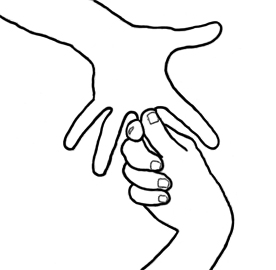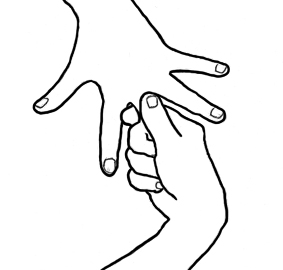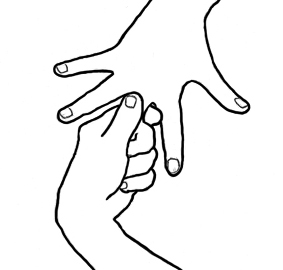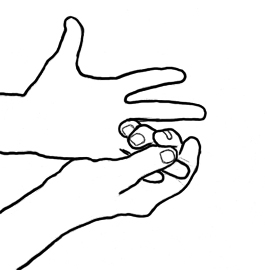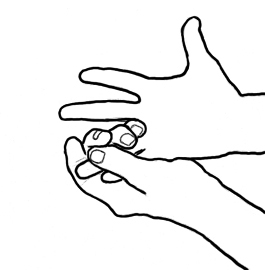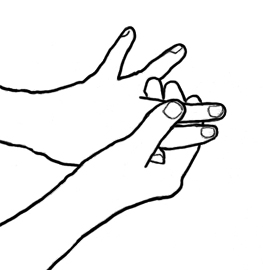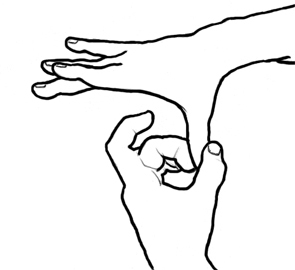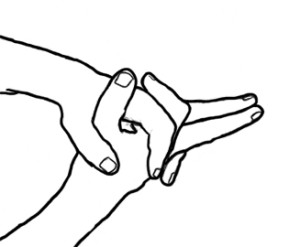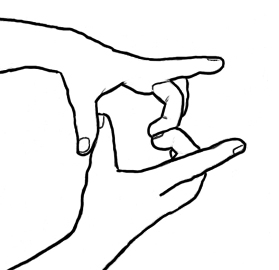 The Jin Shin Jyutsu practice of holding the fingers is not only quite powerful, but holds a special place in the history of Jin Shin Jyutsu. As I’ve described before (What Is Jin Shin Jyutsu?), Master Jiro Murai was a Japanese healer and philosopher who rediscovered the ancient healing practice of Jin Shin Jyutsu in the early 20th century. He was led to this practice when he suffered from health problems. As a young man, his behavior was often reckless and overindulgent. He not only entered eating and drinking contents that involved consuming immense quantities of food and drink, but he would win them! By the time he was 26, he became seriously ill. Medical doctors considered his condition incurable and terminal.
The Jin Shin Jyutsu practice of holding the fingers is not only quite powerful, but holds a special place in the history of Jin Shin Jyutsu. As I’ve described before (What Is Jin Shin Jyutsu?), Master Jiro Murai was a Japanese healer and philosopher who rediscovered the ancient healing practice of Jin Shin Jyutsu in the early 20th century. He was led to this practice when he suffered from health problems. As a young man, his behavior was often reckless and overindulgent. He not only entered eating and drinking contents that involved consuming immense quantities of food and drink, but he would win them! By the time he was 26, he became seriously ill. Medical doctors considered his condition incurable and terminal.
Facing this serious diagnosis, Murai asked to be left alone in a mountain cabin that belonged to his family. He was carried there on a stretcher. He wanted to be left in solitude for seven days and told his family to return on the eighth day.
As he meditated and passed in and out of consciousness during that week, he had visions of spiritual masters using hand mudras. He began to practice these mudras on himself. On the seventh day he underwent an intense healing experience, passing from extreme cold to extreme heat.
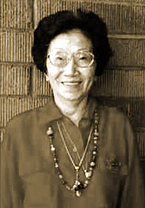 Mary Burmeister, who studied with Master Murai and brought his teachings from Japan to the rest of the world, describes this experience as follows:
Mary Burmeister, who studied with Master Murai and brought his teachings from Japan to the rest of the world, describes this experience as follows:
Each day passed on to the next, becoming conscious and unconscious, with his physical body experiencing loss of heat each day. Then on the seventh day he experienced a feeling of being lifted out of the deep-freeze and thrown into a furnace of fire. When this tremendous heat subsided, he felt no more discomforts. It was like after the passing of a terrible storm. The quiet, the calm, the peace encompassed his whole being. To his amazement and disbelief, he was completely healed.
In response to his healing experience, Master Murai vowed to devote his life to discovering the connection between the hand mudras and his dramatic recovery. He did precisely that and, as a result, we have the healing art of Jin Shin Jyutsu.
How to hold the finger mudras. Their benefits and uses
In the diagrams, you can distinguish between the back of the hand and the palm side of the hand by the fingernails: if you can see fingernails, that’s the back; if you can’t, that’s the palm.
Remember to keep your hands, arms, and shoulders as relaxed as possible while holding the finger mudras.
1. Exhaling the Burdens and Blockages (palm side of middle finger)
Lightly place the whole length of the palm side of your right thumb along the entire length of the palm side of your left middle finger. Wrap the rest of your right fingers around the left middle finger. (Reverse for right middle finger.)
Benefits: Releases generalized tension and stress from head to toe. Helps the exhale so we can empty ourselves of the causes of harmful stagnation and blockages of energy.
Use for: Can’t see too well. Difficult to exhale. Frustrated. Tired all the time. Trouble making decisions. Procrastinate.
2. Inhaling the Abundance (back of middle finger)
Lightly place the whole length of the palm side of your right thumb along the entire length of the back of left middle finger. Gently wrap the rest of your right fingers around the left middle finger. (Reverse for right middle finger.)
Benefits: Makes it easier to inhale the Breath of Life — our source of abundance (prenatal and postnatal Chi).
Use for: Can’t take a deep breath. Hard of hearing. Feet bothering you. Not as alert as usual. Eyes bothering you.
3. Calming and Revitalizing (palm side of little and ring fingers)
Place the palm side of your right thumb across the palm side of your left little and ring fingers. Wrap the rest of your right fingers around the left little and ring fingers. (Reverse for right fingers.)
Benefits: Calms the body, releases nervous tension and stress, revitalizes all the organ functions.
Use for: Nervousness. Worry about the heart. If get out of breath when walking. Always “trying-to.” Depressed/never have any fun.
4. Releasing General Daily Fatigue (thumb, index, middle)
Place the palm side of your right thumb across the back of your left thumb, index and middle fingers. Wrap the rest of your right fingers around the left thumb, index and middle fingers. (Reverse for right thumb and fingers.)
Benefits: Releases fatigue, tension and stress that builds up during the course of the day. Helps release worry, fear, and anger.
Use for: “I get so tired.” Feel insecure about everything (finances, work, relationships). Beginning to feel and look old. Get irritated and angry over nothing. Worry about everything.
5. Total Revitalization (thumb sandwich)
Make a circle with right middle finger and thumb (palm side of thumb covers middle fingernail). Next, slip your left thumb between your right thumb and right middle finger (the palm side of the left thumb will now cover the right middle fingernail). Note that all three nails are facing in the same direction. I call this the “thumb sandwich.” You can think of the right middle finger and thumb as two slices of bread into which you insert your left thumb as the filling. (Reverse for right thumb.)
Benefits: Revitalizes all the bodily functions. Releases the blockages responsible for daily fatigue.
Use for: Always have uneasy feeling. Nothing seems wrong, but get tired all the time. Problems with complexion. Temperamental. Uncontrollable craving for sweets.
6. Breathing Easily (ring fingernail to thumb)
Cover your ring fingernails with the palm side of your thumb on both the left and right hands.
Benefits: Strengthens the respiratory function. Helps balance ear projects. Use while walking, jogging, exercising — helps you breathe more easily. Use when flying, high altitudes (for the ears).
Use for: Bad skin conditions. Feel rejected and unloved and tear up easily. Feel clumsy and all thumbs. Lost common sense. Ears bothering you.
7. Exhaling Dirt, Dust, and Greasy Grime (steeple with middle fingers)
Interlock your fingers. Extend your left and right middle fingers, and adjust your hands so that the palm sides of the middle fingers are touching each other.
Benefits: Releases general daily tension and stress from head, lungs, digestive functions, abdomen, and legs. Strengthens the exhale.
Use for: Harmonizing the total mind/body.
8. Inhaling the Purified Breath of Life (touch middle fingernails)
Touch left and right middle fingernails together.
Benefits: Releases tension in the back, promotes overall feeling of well being. Strengthens ability to inhale and receive the purified breath of life.
Use for: Harmonizing the total mind/body.
How to use the finger mudras
You may find something listed under the benefits and uses that attracts you to a particular mudra. The “thumb sandwich,” for example, is popular for reducing food cravings. You may hold one of the finger mudras (on one or both hands for mudras one through five) at any time during the day for any length of time.
Mary Burmeister taught that if you find one of the finger mudras more comfortable than the others, that’s an indication that your body needs to hold that particular mudra. Continue to favor this mudra until you find that a different one is the most comfortable.
The complete practice of holding the finger mudras includes holding all eight finger positions. As you hold each mudra position, take two slow, relaxed breaths, then continue to the next position. When you finish, there is one more thing to do. The mudras are meant to be practiced for a total of 36 breaths. The eight mudra positions take 26 breaths. So when you finish the eighth mudra, remain in a relaxed, meditative state as you take ten more breaths.
Mary Burmeister recommended that you fold your two hands together as you do the final 10 breaths. But she also said: “There are no rules and regulations.” I like to touch each finger, one for each of the ten breaths. That way I don’t have to use my mind to count, but can remain in a kinesthetic (bodily) state of mind.
Remembering the finger mudras sequence and a video
It may take you a little while to remember the sequence of finger mudras. As I mentioned in connection with the extended sequence of holding the fingers, think of learning to hold the sequence of finger mudras the way you would learn a sequence of dance steps. It’s something you learn with your body more than your mind. Once you’ve learned the mudras, you’ll find that your ability to remember the sequence is quite satisfying — for me it feels like remembering how to play a piece of piano music from memory.
Everyone learns differently, however. Some of us are more oriented towards the visual or the auditory than the kinesthetic. Here’s a video that you may find helpful. It’s by Mea Hutchinson, a Jin Shin Jyutsu teacher in British Columbia. The first 2:22 minutes are an introduction to the finger mudras. Once you’re familiar with the introduction, you can watch the rest of the video repeatedly to help you remember the sequence.
Related posts & pages:
What Is Jin Shin Jyutsu
Jin Shin Jyutsu Resources
Creating Your Own Acupressure Self-Help Practice
The Jin Shin Jyutsu practice of holding the fingers
The Jin Shin Jyutsu extended sequence for holding the fingers

